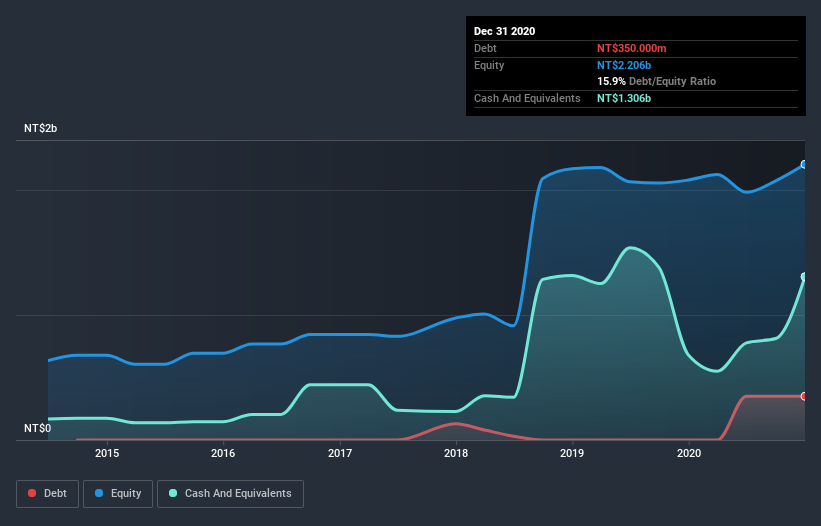- Taiwan
- /
- Electronic Equipment and Components
- /
- TWSE:3530
We Think Silicon Optronics (TPE:3530) Can Stay On Top Of Its Debt
The external fund manager backed by Berkshire Hathaway's Charlie Munger, Li Lu, makes no bones about it when he says 'The biggest investment risk is not the volatility of prices, but whether you will suffer a permanent loss of capital.' When we think about how risky a company is, we always like to look at its use of debt, since debt overload can lead to ruin. We can see that Silicon Optronics, Inc. (TPE:3530) does use debt in its business. But is this debt a concern to shareholders?
Why Does Debt Bring Risk?
Debt and other liabilities become risky for a business when it cannot easily fulfill those obligations, either with free cash flow or by raising capital at an attractive price. Ultimately, if the company can't fulfill its legal obligations to repay debt, shareholders could walk away with nothing. However, a more frequent (but still costly) occurrence is where a company must issue shares at bargain-basement prices, permanently diluting shareholders, just to shore up its balance sheet. By replacing dilution, though, debt can be an extremely good tool for businesses that need capital to invest in growth at high rates of return. The first step when considering a company's debt levels is to consider its cash and debt together.
Check out our latest analysis for Silicon Optronics
What Is Silicon Optronics's Net Debt?
As you can see below, at the end of December 2020, Silicon Optronics had NT$350.0m of debt, up from none a year ago. Click the image for more detail. But it also has NT$1.31b in cash to offset that, meaning it has NT$956.4m net cash.

How Strong Is Silicon Optronics' Balance Sheet?
We can see from the most recent balance sheet that Silicon Optronics had liabilities of NT$446.6m falling due within a year, and liabilities of NT$359.7m due beyond that. On the other hand, it had cash of NT$1.31b and NT$50.9m worth of receivables due within a year. So it actually has NT$551.0m more liquid assets than total liabilities.
This surplus suggests that Silicon Optronics has a conservative balance sheet, and could probably eliminate its debt without much difficulty. Simply put, the fact that Silicon Optronics has more cash than debt is arguably a good indication that it can manage its debt safely.
Even more impressive was the fact that Silicon Optronics grew its EBIT by 105% over twelve months. If maintained that growth will make the debt even more manageable in the years ahead. When analysing debt levels, the balance sheet is the obvious place to start. But ultimately the future profitability of the business will decide if Silicon Optronics can strengthen its balance sheet over time. So if you're focused on the future you can check out this free report showing analyst profit forecasts.
But our final consideration is also important, because a company cannot pay debt with paper profits; it needs cold hard cash. Silicon Optronics may have net cash on the balance sheet, but it is still interesting to look at how well the business converts its earnings before interest and tax (EBIT) to free cash flow, because that will influence both its need for, and its capacity to manage debt. Over the last three years, Silicon Optronics reported free cash flow worth 19% of its EBIT, which is really quite low. For us, cash conversion that low sparks a little paranoia about is ability to extinguish debt.
Summing up
While it is always sensible to investigate a company's debt, in this case Silicon Optronics has NT$956.4m in net cash and a decent-looking balance sheet. And we liked the look of last year's 105% year-on-year EBIT growth. So is Silicon Optronics's debt a risk? It doesn't seem so to us. When analysing debt levels, the balance sheet is the obvious place to start. However, not all investment risk resides within the balance sheet - far from it. These risks can be hard to spot. Every company has them, and we've spotted 1 warning sign for Silicon Optronics you should know about.
If you're interested in investing in businesses that can grow profits without the burden of debt, then check out this free list of growing businesses that have net cash on the balance sheet.
If you decide to trade Silicon Optronics, use the lowest-cost* platform that is rated #1 Overall by Barron’s, Interactive Brokers. Trade stocks, options, futures, forex, bonds and funds on 135 markets, all from a single integrated account. Promoted
New: Manage All Your Stock Portfolios in One Place
We've created the ultimate portfolio companion for stock investors, and it's free.
• Connect an unlimited number of Portfolios and see your total in one currency
• Be alerted to new Warning Signs or Risks via email or mobile
• Track the Fair Value of your stocks
This article by Simply Wall St is general in nature. It does not constitute a recommendation to buy or sell any stock, and does not take account of your objectives, or your financial situation. We aim to bring you long-term focused analysis driven by fundamental data. Note that our analysis may not factor in the latest price-sensitive company announcements or qualitative material. Simply Wall St has no position in any stocks mentioned.
*Interactive Brokers Rated Lowest Cost Broker by StockBrokers.com Annual Online Review 2020
Have feedback on this article? Concerned about the content? Get in touch with us directly. Alternatively, email editorial-team (at) simplywallst.com.
About TWSE:3530
Silicon Optronics
Designs, develops, and sells CMOS image sensors in Taiwan, Hong Kong, China, and internationally.
Flawless balance sheet with minimal risk.
Similar Companies
Market Insights
Community Narratives




